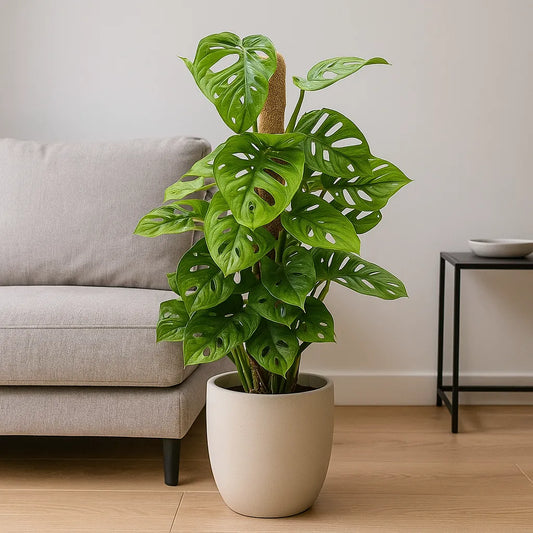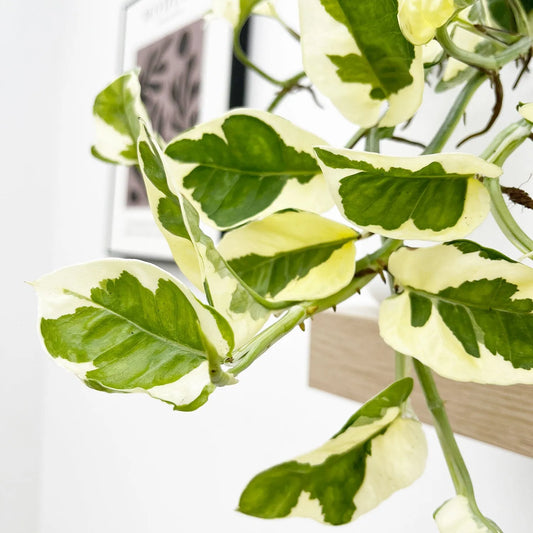A complete guide to types of tropical houseplant
Tropical house plants can bring colour and exotic flair to your home, even if you live in a colder climate. While some tropical house plants are best known for their eye-popping flowers, others are loved for their large, unusually patterned or variegated leaves.
Dieffenbachia (Dumb Cane)
Dieffenbachia, or Dumb Cane, are characterised by broad leaves with a mix of marbled green, white and yellow colouring. You won't find colouring like this in any other indoor plant!
One of the myths surrounding the Dumb Cane is that it is highly poisonous. While the plant is poisonous, it's very rare that it would ever kill an animal or person if it's consumed. However, if a pet was to get hold of it and consume it, the pet would suffer with an extremely swollen mouth, which is where the nickname Dumb Cane comes from.
If you take great care when placing this plant in your home and move it away from pets and children and always wash your hands after handling it, you shouldn't have too much of a problem.
Dieffenbachia are relatively easy to grow and will survive through neglect and poor treatment so, if you're not reliable at watering or looking after houseplants, opt for a Dieffenbachia over an Alocasia or Calathea.
Basic care guidelines for Dieffenbachia include:
Light: Prefers indirect, bright light
Water: Water well but then leave soil to dry for a while, don't water too often
Humidity: Medium to low
Temperature: Warm (between 16℃ and 27℃)
Bromeliads
Bromeliads can live both indoors and outdoors but prefer a warmer climate so, here in the Uk, they're probably better to be grown as tropical house plants.
Bromeliads are the easiest of all the types of tropical house plants to grow and are much more hardy than others, adapting easily to their surroundings. They're available in a wide variety of colours and textures so, if you're new to house plants, these are a safe option.
Basic care guidelines for Bromeliads include:
Light: Different types of Bromeliads prefer different light conditions ranging from bright, indirect sunlight to constant shade
Water: Adapted to withstand drought conditions and are much less tolerant of overwatering
Humidity: Prefer 60% humidity
Temperature: Between 13℃ and 26℃, do not expose to temperatures below 4℃
Philodendron
There are over 500 species of Philodendron so there's definitely something for every plant lover! The two main types of Philodendron are vines and non-climbers, so if you want a low maintenance hanging or freestanding plant, these are the plants you should be looking for.
Basic care guidelines for Philodendron include:
Light: Dappled, bright light to mimic the light conditions you'd find under a tropical canopy
Water: Keep the growing medium moist at all times
Humidity: Love humidity so make sure you give them a mist every other day during the growing season
Temperature: Philodendrons prefer temperatures above 13℃
Ficus
Ficus plants are much more fussy than other types of tropical house plants. However, a ficus that is well-grown and looked after is the absolute pinnacle of house plants.
Ficus plants grow large, glossy leaves and provide a real statement in any room of the house so they're worth the love and care they require. Ficus plants come in a range of sizes and varieties so you'll be able to find something for your home and any room in this species.
Basic care guidelines for Ficus include:
Light: Bright light with indirect sunlight - it's important to check each plant to make sure this is correct
Water: Extremely sensitive to overwatering so stick to watering when the soil is dry
Humidity: Average humidity, mist occasionally
Temperature: Between 15℃ and 24℃
Alocasia
If you're a house plant enthusiast looking for something unique to your collection, an Alocasia is the perfect type of tropical house plant. These plants are grown and desired for their striking foliage but they can be hard to care for so, if you're new to house plants, it might be better to try your hand with something a little easier to care for first.
If you're a seasoned house plant carer, Alocasia are a rewarding species to add to your collection. They're very picky about their conditions so, if you're prepared to offer lots of care, you will be rewarded with a beautiful plant.
Basic care guidelines for Alocasia include:
Light: Bright, diffused light - direct sunlight will burn the leaves
Water: Alocasia love water so always keep the soil moist, but not soggy. Water less during the winter when the plant is dormant
Humidity: Prefer very humid conditions
Temperature: Struggle below 15℃ and should be kept away from cold draughts near windows, doors and air conditioning.
Anthurium
There are two types of Anthurium, flowering and non flowering. The flowering variety are highly sought after for their beautiful, bright flowers but the non flowering variety are just as beautiful featuring either narrow or heart shaped leaves and often heavy veining.
These plants require special care while they're growing but their colour and beauty more than make up for the extra care needed. If you want these plants in your collection, it's important to know how to care for them properly.
Basic care guidelines for Anthurium include:
Light: Bright, indirect light - direct light can burn the leaves
Water: Only water when the soil feels dry, these plants are susceptible to root rot
Humidity: Love humidity! These plants prefer humidity of 80%
Temperature: Prefer warm temperatures between 21℃ to 32℃
Schefflera
Schefflera are also known as umbrella plants and are one of the most popular types of tropical house plants. They're perfect for use as a background plant amongst others or can be used one their own to provide a canopy effect in a bright corner of the room.
Whilst some Schefflera can bloom, it's unlikely that it will flower as a house plant. These plants are not tricky to grow so are perfect even if you're not a seasoned house plant owner.
Basic care guidelines for Schefflera include:
Light: Bright, indirect light
Water: Water weekly during the growing season but cut this down during the winter.
Humidity: Prefers a lot of humidity
Temperature: Prefer a temperature range between 15℃ and 21℃, avoid draughts
Monstera
The Monstera species of house plants is best known for the Monstera Deliciosa (Swiss Cheese Plant) which is recognisable by the slits and holes in its leaves. It has become one of the most popular house plants around and can grow to a huge size.
Provide Monstera plants with everything they need and a bit of space to sprawl out and you'll be enjoying these plants for years to come.
Basic care guidelines for Monstera are:
Light: Provide plenty of indirect light, the leaves will burn in direct sunlight
Water: Weekly and allow the soil to dry out completely before watering again
Humidity: Normal humidity levels in the home are ok but, if you can, Monstera prefer humid conditions where possible
Temperature: 18℃ to 30℃
Croton
In tropical climates, Croton plants are grown outside but, in the UK, they make perfect house plants. With a wide variety of leaf shapes and colours within this species, plant lovers have so many different plants to choose from.
When you first receive a Croton plant, you might find that it starts to shed it's leaves. Usually, this is not because it's dying, it's because these plants do not like to be moved and can go into shock. Once you've found a home for your Croton plant, it's better to leave it there. Proper care and attention will help the leaves to come back in no time.
Basic care guidelines for Croton are:
Light: High light to medium or low light - this depends on the variety you choose. As a rule of thumb, the more variegated or colourful the plant is, the more light it will need.
Water: Keep the soil moist but make sure it's not constantly wet
Humidity: High humidity
Temperature: This plant will not thrive in extreme heat so temperatures should be below 26℃ but above 13 ℃ for optimal growing conditions
Pothos
Pothos house plants are a great starter plant if you're completely new to houseplants. They're easy to care for and relatively undemanding so will provide an easy way to add that all-important greenery to your home.
These plants will thrive in a variety of conditions so it really is hard to go wrong. They make the perfect plant for the office or bathroom because they're extremely tolerant of low light conditions.
Basic care guidelines for Pothos are:
Light: Anything from bright indirect light to low light
Water: Pothos prefer the soil to dry out completely before you water again
Humidity: Prefer high humidity but is extremely tolerant so will survive in low humidity environments
Temperature: Prefer common room temperatures between 18℃ and 24℃











Leave a comment
Please note, comments need to be approved before they are published.